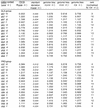Regularities of context-dependent codon bias in eukaryotic genes
- PMID: 11861911
- PMCID: PMC101244
- DOI: 10.1093/nar/30.5.1192
Regularities of context-dependent codon bias in eukaryotic genes
Abstract
Nucleotides surrounding a codon influence the choice of this particular codon from among the group of possible synonymous codons. The strongest influence on codon usage arises from the nucleotide immediately following the codon and is known as the N1 context. We studied the relative abundance of codons with N1 contexts in genes from four eukaryotes for which the entire genomes have been sequenced: Homo sapiens, Drosophila melanogaster, Caenorhabditis elegans and Arabidopsis thaliana. For all the studied organisms it was found that 90% of the codons have a statistically significant N1 context-dependent codon bias. The relative abundance of each codon with an N1 context was compared with the relative abundance of the same 4mer oligonucleotide in the whole genome. This comparison showed that in about half of all cases the context-dependent codon bias could not be explained by the sequence composition of the genome. Ranking statistics were applied to compare context-dependent codon biases for codons from different synonymous groups. We found regularities in N1 context-dependent codon bias with respect to the codon nucleotide composition. Codons with the same nucleotides in the second and third positions and the same N1 context have a statistically significant correlation of their relative abundances.
Figures




Similar articles
-
Comparative analysis of the base biases at the gene terminal portions in seven eukaryote genomes.Nucleic Acids Res. 2003 Sep 1;31(17):5195-201. doi: 10.1093/nar/gkg701. Nucleic Acids Res. 2003. PMID: 12930971 Free PMC article.
-
Codon usage bias is correlated with gene expression levels in the fission yeast Schizosaccharomyces pombe.Genes Cells. 2009 Apr;14(4):499-509. doi: 10.1111/j.1365-2443.2009.01284.x. Genes Cells. 2009. PMID: 19335619
-
Codon usage and tRNA genes in eukaryotes: correlation of codon usage diversity with translation efficiency and with CG-dinucleotide usage as assessed by multivariate analysis.J Mol Evol. 2001 Oct-Nov;53(4-5):290-8. doi: 10.1007/s002390010219. J Mol Evol. 2001. PMID: 11675589
-
Selection on codon bias.Annu Rev Genet. 2008;42:287-99. doi: 10.1146/annurev.genet.42.110807.091442. Annu Rev Genet. 2008. PMID: 18983258 Review.
-
Codon usage bias: causative factors, quantification methods and genome-wide patterns: with emphasis on insect genomes.Biol Rev Camb Philos Soc. 2013 Feb;88(1):49-61. doi: 10.1111/j.1469-185X.2012.00242.x. Epub 2012 Aug 14. Biol Rev Camb Philos Soc. 2013. PMID: 22889422 Review.
Cited by
-
Sequences encoding identical peptides for the analysis and manipulation of coding DNA.Bioinformation. 2013 May 8;9(10):511-7. doi: 10.6026/97320630009511. Print 2013. Bioinformation. 2013. PMID: 23861567 Free PMC article.
-
3-base periodicity in coding DNA is affected by intercodon dinucleotides.Bioinformation. 2011;6(9):327-9. doi: 10.6026/97320630006327. Epub 2011 Jul 19. Bioinformation. 2011. PMID: 21814388 Free PMC article.
-
Synonymous but not the same: the causes and consequences of codon bias.Nat Rev Genet. 2011 Jan;12(1):32-42. doi: 10.1038/nrg2899. Epub 2010 Nov 23. Nat Rev Genet. 2011. PMID: 21102527 Free PMC article. Review.
-
Molecular mechanism of translational stalling by inhibitory codon combinations and poly(A) tracts.EMBO J. 2020 Feb 3;39(3):e103365. doi: 10.15252/embj.2019103365. Epub 2019 Dec 20. EMBO J. 2020. PMID: 31858614 Free PMC article.
-
Large scale comparative codon-pair context analysis unveils general rules that fine-tune evolution of mRNA primary structure.PLoS One. 2007 Sep 5;2(9):e847. doi: 10.1371/journal.pone.0000847. PLoS One. 2007. PMID: 17786218 Free PMC article.
References
-
- Yarus M. and Folley,L.S. (1984) Sence codons are found in specific contexts. J. Mol. Biol., 182, 529–540. - PubMed
-
- Shpaer E.G. (1986) Constraints on codon context in Escherichia coli genes. Their possible role in modulating the efficiency of translation. J. Mol. Biol., 188, 555–564. - PubMed
-
- Gouy M. (1987) Codon contexts in Enterobacterial and Coliphage genes. Mol. Biol. Evol., 4, 426–444. - PubMed
-
- Karlin S. and Mrazek,J. (1996) What drives codon choices in human genes? J. Mol. Biol., 262, 459–472. - PubMed
MeSH terms
Substances
LinkOut - more resources
Full Text Sources
Other Literature Sources
Molecular Biology Databases

